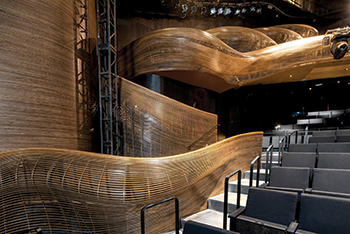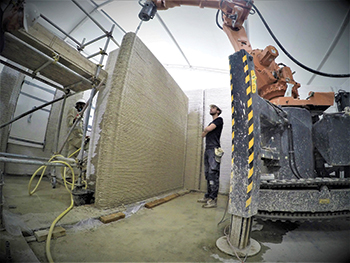
 CC and CCH are used for bund lining, containment, channel lining and slope protection in the region.
CC and CCH are used for bund lining, containment, channel lining and slope protection in the region.
BMC Gulf, the UAE’s leading specialist in geosynthetics and thermoplastic materials, has introduced another new class of revolutionary products to the country’s construction industry.
This new class of construction materials is known as geosynthetic cementitious composite mats or GCCMs. Concrete Canvas (CC) and CC Hydro (CCH) are the two products from this class of products that have been launched on the UAE market.
Concrete Canvas is a flexible, concrete-filled geotextile that hardens on hydration to form a thin, durable, waterproof and environment-friendly concrete layer.
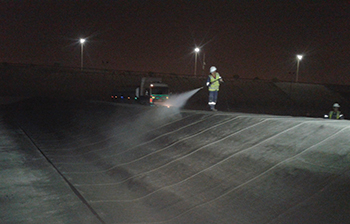 |
|
The use of CC products reduces preparation and installation times. |
CC was first produced by its eponymous Concrete Canvas Limited of the UK.
“Essentially, it’s concrete on a roll,” Fabian Beermann, managing partner at BMC Gulf, tells Gulf Construction.
CC installations can be carried out without any experience; simply unroll the material, secure and add water, he says.
On the other hand, CC Hydro (CCH) – a CC variant – combines the company’s innovative material technology with a highly impermeable, chemically-resistant geomembrane liner. “The product was specifically developed for use in containment applications and incorporates a high-visibility welding strip which allows joints to be thermally welded with a double-track or triple-track air channel for on-site testing,” says Beermann.
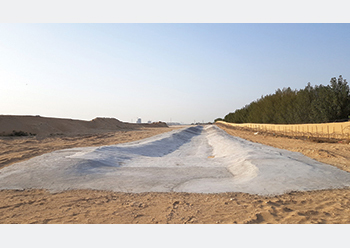 |
|
Concrete Canvas ... concrete-filled geotextile that forms a thin, durable concrete layer. |
CC’s growing worldwide popularity is built on its numerous benefits in comparison to traditional concreting methods and typical alternatives.
The core applications of CC and CCH products are in channel lining, slope protection, bund lining and secondary containment, and concrete remediation.
Beermann says channel lining is CC’s most common application. “The benefits of using CC for channel or ditch lining projects are numerous. As a result, it is one of the core applications, accounting for the majority of the company’s worldwide projects,” he adds.
This is particularly true for the rail, road and civil infrastructure sectors where CC products have been embraced as a cost-effective, rapidly and easily installed and environment-friendly alternative to traditional channel and ditch lining methods such as poured and pre-cast concrete.
Another of CC’s core applications is slope protection where this flexible concrete material is increasingly being utilised.
CC and CCH are popular solutions for bund lining and containment in the petrochemical, oil and gas and other utilities sectors, while CC has become widely used for concrete remediation and weed suppression.
In the Middle East specifically, CC and CCH are mostly commonly used for bund lining, containment, channel lining and slope protection.
Beermann says CC products have been specified by some of the region’s petrochemical and oil and gas giants such as Saudi Aramco, Petroleum Development Oman (PDO) and Oman Refinery Company (Orpic).
Unique properties
According to Beermann, the increasing popularity of CC is due to its unique properties, which allow clients and contractors to both address and accommodate common challenges in construction projects across various sectors worldwide.
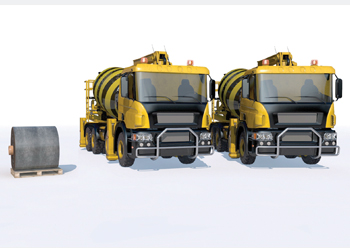 |
|
One pallet of CC equates to two 17-tonne ready-mix concrete trucks. |
These challenges include fluctuating and extreme weather and environmental conditions, varying temperatures, and access restrictions, while providing cost and time savings compared to traditional concreting methods.
“For example, the high temperatures experienced in the Middle East, and the often unstable, sand-based substrates can provide unique challenges for construction projects,” he explains. “Here, CC products can be used as a direct replacement for traditional poured, sprayed and precast concrete, considerably reducing the ground work required and simplifying logistics both to and on site.
“The flexibility of both material variants allows them to be cut to length on site for easier transportation and to accommodate existing assets. This, in turn, reduces risks and health and safety concerns on sites with regards to sensitive infrastructure, such as on petrochemical, oil and gas and other utilities sites.”
A fundamental benefit of using CC products is that they minimise occupational health and safety (OHS) risk. This risk is reduced as a result of the lower plant requirements and less labour and time spent on site. This is particularly important on petrochemical and utilities sites where there are strict OHS rules and regulations for maintenance and construction works, Beermann points out.
The use of CC products also eliminates rebound associated with sprayed concrete, and reduces preparation and installation times, while long lead times and curing times – typical for traditional methods – do not need to be considered. CC can be installed up to 10 times faster than conventional methods and reaches 80 per cent of its final strength within 24 hours of hydration.
CC is recognised as an eco-friendly concrete alternative by the UK’s Environment Agency, which has specified the material for a number of projects in environmentally sensitive areas, and has been used by environmental agencies worldwide.
Furthermore, the material has a low alkaline reserve and washout rate, eliminating the need to treat runoff, and resulting in a lower carbon footprint.
“The material also offers a significant embodied carbon reduction compared to traditional concretes. When considering the raw materials alone, a CC-lined channel will contain just 45 per cent of the embodied carbon of a conventional concrete channel – a 55 per cent saving,” Beermann points out.
One pallet of CC equates to two 17-tonne ready-mix concrete trucks. When considering this and the associated reduction in logistical requirements, CC may be transported five times further than locally sourced concrete. As a result, CC products also offer more than 50 per cent reduction in transportation carbon costs, he adds.
Commenting on the future of CC in the Middle East, Concrete Canvas’ business distribution manager for the Middle East and North Africa (Mena) region Samer Ali Hasan predicts the oil and gas sector will become increasingly dominant, with CC and CCH products expected to be used heavily in this sector for the company’s three core applications: bund lining, slope protection and channel lining.
Beermann agrees, adding: “We are currently receiving a very strong interest from clients, consultants and EPC (engineering, procurement and construction) contractors) to use CC products in their ongoing and future projects.
“Considering the benefits of CC, we are certain these products will provide a more efficient and sustainable alternative to many conventional concrete applications throughout the Middle Eastern market.”
Concrete Canvas Limited was established in 2005 following the development of the Concrete Canvas Shelter, a concept for creating rapidly deployable shelters for humanitarian disaster relief, which came to fruition while inventors William Crawford and Peter Brewin were university students.
The shelters were inspired by plaster casts. The idea was based around creating a concrete fabric which could be used to form the hard shells of the shelters which resemble Nissen huts.
In 2007, the company moved to South Wales from England and two years later, began commercial volume production of the revolutionary CC fabric after discovering a gap in the market for it as a solution for rapidly deployable and adaptable concrete for erosion control applications.
In 2015, Concrete Canvas Limited launched a variant of CC called CC Hydro, the world’s first all-in-one armoured impermeable liner for containment applications.





















_0001.jpg)


.jpg)
















.jpg)








.jpg)



